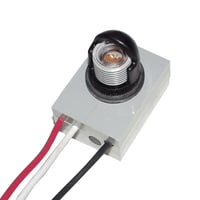Energy Efficiency | March 17, 2020
Photocell Technology and LED Lighting
Let’s face the facts: you probably have LED lighting installed in your building. To what extent, which fixtures and whether you’re getting utility money to cover the cost is another story. But LED lighting has grown in such prevalence over the last 10+ years that it’s a solid bet to assume you have – at a minimum – some LED lighting installed.
LED fixtures improve energy efficiency by requiring less power to produce light and having a long lifespan compared to other bulbs. Adding controls to LED lighting can further improve their effectiveness. One of these useful controls is what we’ll examine here: photocell technology.

What is a photocell?
A photocell is a light sensitive resistor that attaches to either a circuit or lighting device and changes resistance depending on the amount of light available. Short for “photoelectric cells,” photocells are electronic components, typically small in size but come in a number of designs for different applications.
Photocells can be mounted to directly to a light fixture or wired into the existing circuit depending on how granular of a control level you would like to achieve. Most manufacturers even have an option for their fixtures to be factory installed with photocells, reducing labor cost and time in the field.

A photocell works because of a combination of electrical resistance and the photoelectric effect. A photocell has high resistance. As the energy of photons hitting the semiconductor frees electrons to flow when the photocell is exposed to increased light levels, the resistance decreases which dims or turn off the light. Read more about the science of photocells at Science Direct.
How photocell technology saves energy in LED lighting
So how does a photocell save energy? By automatically responding to the amount of light available, a photocell can tell its fixture(s) to remain off until a certain light level is reached without the need to manually turn anything off, lowering the amount of energy required to power that fixture over a 24 hour period.
You should be using photocell technology in every LED lighting project wherever possible. Any fixture located near windows or doors with access to natural light should include photocell technology to ensure you are capturing the maximum amount of energy savings.
While there are dozens of additional ways to save energy in properly engineered LED lighting projects, photocell technology is something we often leverage because it is typically cost effective and easy to implement.
Got questions about adding photocells to your current fixtures? Let’s chat »
Related Posts
Discover more content and insights from Mantis Innovation

The Cost of Inaction: Why Businesses Should Act Now on Energy Efficiency
In today's fast-paced business environment, the financial and operational losses businesses incur by delaying energy efficiency improvements, the "cost of inaction," is more relevant than ever.

In today’s AI era, human intelligence is the key to data center facility and energy optimization
Nowhere else in modern industry do artificial and human intelligence converge with such transformative potential as in the world of data centers. As AI's extraordinary growth accelerates demand for

Your Guide to LED Lighting for Business and Commercial Buildings
Never to be underestimated, LED lighting and well-designed lighting retrofits and upgrades offer businesses big improvements like reduced energy costs, reduced emissions, and improved working

Five Trends Driving Data Center Facility Energy Optimization
Today’s digital economy, commercial and industrial digitalization, and the recent explosion in artificial intelligence and machine learning (AI/ML) powered computing are driving massive growth in